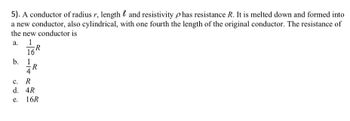
University Physics Volume 2
18th Edition
ISBN: 9781938168161
Author: OpenStax
Publisher: OpenStax
expand_more
expand_more
format_list_bulleted
Question
thumb_up100%

Transcribed Image Text:5). A conductor of radius r, length & and resistivity p has resistance R. It is melted down and formed into
a new conductor, also cylindrical, with one fourth the length of the original conductor. The resistance of
the new conductor is
a.
1
R
161
b.
1
R
C.
R
d. 4R
e. 16R
Expert Solution
This question has been solved!
Explore an expertly crafted, step-by-step solution for a thorough understanding of key concepts.
Step by stepSolved in 2 steps with 2 images

Knowledge Booster
Similar questions
- Using your understanding of the nature of internal energy and temperature, explain why we might expect the resistance of a solid to increase if its temperature increases.arrow_forwardA 20.00-V battery is used to supply current to a 10-k resistor. Assume the voltage drop across any wires used for connections is negligible, (a) What is the current through the resistor? (b) What is the power dissipated by the resistor? (c) What is the power input from the battery; assuming all the electrical power is dissipated by the resistor? (d) What happens to the energy dissipated by the resistor?arrow_forward-gauge copper wire has a diameter of 9.266 mm. Calculate the power loss in a kilometer of such wire when it carries 1.00102 A.arrow_forward
- Check Your Understanding Handheld calculators often use small solar cells to supply the energy required to complete the calculations needed to complete your next physics exam. The current needed to run your calculator can be as small as 0.30 mA. How long would it take for 1.00 C of charge to flow from the solar cells? Can solar cells be used, instead of batteries, to stall traditional internal combustion engines presently used in most cars and trucks?arrow_forward(Indicates a review question, which means it requires only a basic understanding of the material to answer. Questions without this designation typically require integrating or extending the concepts presented thus far.) . Six resistors, all having the same temperatures and compositions, are each attached to a battery with voltage V to form a simple circuit. The resistors have different lengths, l, but the same diameters. Rank the circuits according to the current that flows through the resistor from smallest to greatest. If two (or more) circuits have the same current flowing, give them the same ranking. Explain the rationale you used to establish your rankings. Circuit 1: l = 2 cm; V = 3 V Circuit 2: l = 2 cm; V = 6 V Circuit 3: l = 1 cm; V = 3 V Circuit 4: l = 1 cm; V = 6 V Circuit 5: l = 3cm; V = 2 V Circuit 6: l = 3cm; V = 6 Varrow_forwardCheck Your Understanding A strain gauge is an electrical device to measure strain, as shown below. It consists of a flexible, insulating backing that supports a conduction foil pattern. The resistance of the foil changes as the backing is stretched. How does the strain gauge resistance change? Is the strain gauge affected by temperature changes?arrow_forward
- (a) To what temperature must you raise a copper wire, originally at 20.0°C, to double its resistance, neglecting any changes in dimensions? (b) Does this happen in household wiring under ordinary circumstances?arrow_forwardWhat is die basic operation of an ohmmeter as it measures a resistor?arrow_forwardA 12.0-V emf automobile battery has a terminal voltage of 16.0 V when being charged by a current of 10.0 A. (a) What is the battery’s internal resistance? (b) What power is dissipated inside the battery? (c) At what rate (in °C/min ) will its temperature increase if its mass is 20.0 kg and it has a specific heat of 0.300 kcal/kg • °C, assuming no heat escapes?arrow_forward
- In Figure 21.41. does the graph indicate the time constant is shorter for discharging than for charging? Would you expect ionized gas to have low resistance? How would you adjust R to get a longer time between flashes? Would adjusting R affect the discharge time?arrow_forward(Indicates a review question, which means it requires only a basic understanding of the material to answer. Questions without this designation typically require integrating or extending the concepts presented thus far.) . A solid metal cylinder has a certain resistance. It is then heated and carefully stretched to form a longer, thinner cylinder. After it cools, will its resistance be the same as, greater than, or less than what it was before? Explain our choice.arrow_forwardThe quantity of charge q (in coulombs) that has passed through a surface of area 2.00 cm2 varies with time according to the equation q = 4t3 + 5t + 6, where t is in seconds. (a) What is the instantaneous current through the surface at t = 1.00 s? (b) What is the value of the current density?arrow_forward
arrow_back_ios
SEE MORE QUESTIONS
arrow_forward_ios
Recommended textbooks for you

 College PhysicsPhysicsISBN:9781285737027Author:Raymond A. Serway, Chris VuillePublisher:Cengage Learning
College PhysicsPhysicsISBN:9781285737027Author:Raymond A. Serway, Chris VuillePublisher:Cengage Learning
 College PhysicsPhysicsISBN:9781938168000Author:Paul Peter Urone, Roger HinrichsPublisher:OpenStax College
College PhysicsPhysicsISBN:9781938168000Author:Paul Peter Urone, Roger HinrichsPublisher:OpenStax College Principles of Physics: A Calculus-Based TextPhysicsISBN:9781133104261Author:Raymond A. Serway, John W. JewettPublisher:Cengage Learning
Principles of Physics: A Calculus-Based TextPhysicsISBN:9781133104261Author:Raymond A. Serway, John W. JewettPublisher:Cengage Learning Physics for Scientists and Engineers, Technology ...PhysicsISBN:9781305116399Author:Raymond A. Serway, John W. JewettPublisher:Cengage Learning
Physics for Scientists and Engineers, Technology ...PhysicsISBN:9781305116399Author:Raymond A. Serway, John W. JewettPublisher:Cengage Learning


College Physics
Physics
ISBN:9781285737027
Author:Raymond A. Serway, Chris Vuille
Publisher:Cengage Learning


College Physics
Physics
ISBN:9781938168000
Author:Paul Peter Urone, Roger Hinrichs
Publisher:OpenStax College

Principles of Physics: A Calculus-Based Text
Physics
ISBN:9781133104261
Author:Raymond A. Serway, John W. Jewett
Publisher:Cengage Learning

Physics for Scientists and Engineers, Technology ...
Physics
ISBN:9781305116399
Author:Raymond A. Serway, John W. Jewett
Publisher:Cengage Learning